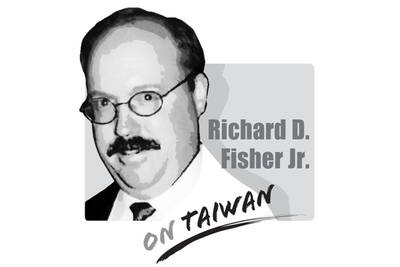Quite a clamor has been coming from within the Chinese Nationalist Party (KMT) regarding KMT Chairwoman Hung Hsiu-chu’s (洪秀柱) planned meeting with Chinese President Xi Jinping (習近平) next week.
Before her presidential candidacy was rescinded by the KMT in October last year, Hung proposed a “one China, same interpretation” formula for her cross-strait policy, describing it as an “advanced version” of the so-called “1992 consensus,”
The “1992 consensus” supposedly refers to a tacit understanding between the KMT and the Chinese government that both sides of the Taiwan Strait acknowledge that there is “one China,” with each side having its own interpretation of what “China” means.
In light of Hung’s perceived inclination to remove the “different interpretations” clause from the “1992 consensus,” the KMT caucus last week demanded that Hung, who was elected party chairwoman in March, clearly note the “one China, different interpretations” aspect of the “consensus” when she meets Xi. In a remark clearly directed at Hung, former vice president Wu Den-yih (吳敦義) on Sunday last week warned against any “willful interpretations” of the “one China, different interpretations” framework.
While the KMT caucus, Wu and KMT Vice Chairman Hau Lung-bin (郝龍斌) have seemingly berated Hung for distorting the party’s long-held stance that “different interpretations” forms part of the “1992 consensus,” it is the KMT’s top brass who have betrayed the party’s commitment to “different interpretations.”
A case in point is when then-KMT chairman Eric Chu (朱立倫), during his meeting with Xi in Beijing in April last year, recast the “1992 consensus” under Beijing’s “one China” framework by saying that the consensus reached in 1992 was that “both sides of the Taiwan Strait belong to the same one China, with differences in its connotation.” Chu’s remarks essentially redefined the “1992 consensus” on Beijing’s terms and refashioned it under Beijing’s “one China” principle.
Another case in point is when then-president Ma Ying-jeou (馬英九) met Xi in Singapore in November last year. In his public comments, Ma stressed the “one China” principle of the “1992 consensus” without mentioning the “different interpretations” component; he also did not mention the Republic of China (ROC).
During his presidency, Ma repeatedly said that Taiwan’s adherence to the “1992 consensus” allows for the recognition of the ROC on an “equal footing” with the People’s Republic of China (PRC). However, when he finally had an opportunity to prove to Taiwanese and the international community that the “1992 consensus” allows for an “equal footing,” not only did he not mention the ROC in front of Xi, but he went one step further by defining the “1992 consensus” in line with the “one China” principle upheld by Beijing.
The underlying message of the “1992 consensus” has always been the “one China” principle, and there is no room for different interpretations: Beijing has never acknowledged “each side having its own interpretation” when it speaks of the “1992 consensus.”
The clamoring within the KMT over Hung’s perceived inclination toward a “one China, same interpretation” formula and demands for her to clearly note that the “one China, different interpretations” aspect of the “1992 consensus” has been blown out of proportion. Regardless of what uniform tone the KMT eventually reaches on describing the “1992 consensus,” no one from the KMT dares mention the Republic of China or the “different interpretations” component of the “1992 consensus” the moment they stand in front of Xi.

On Sept. 3 in Tiananmen Square, the Chinese Communist Party (CCP) and the People’s Liberation Army (PLA) rolled out a parade of new weapons in PLA service that threaten Taiwan — some of that Taiwan is addressing with added and new military investments and some of which it cannot, having to rely on the initiative of allies like the United States. The CCP’s goal of replacing US leadership on the global stage was advanced by the military parade, but also by China hosting in Tianjin an August 31-Sept. 1 summit of the Shanghai Cooperation Organization (SCO), which since 2001 has specialized
In an article published by the Harvard Kennedy School, renowned historian of modern China Rana Mitter used a structured question-and-answer format to deepen the understanding of the relationship between Taiwan and China. Mitter highlights the differences between the repressive and authoritarian People’s Republic of China and the vibrant democracy that exists in Taiwan, saying that Taiwan and China “have had an interconnected relationship that has been both close and contentious at times.” However, his description of the history — before and after 1945 — contains significant flaws. First, he writes that “Taiwan was always broadly regarded by the imperial dynasties of
The Chinese Communist Party (CCP) will stop at nothing to weaken Taiwan’s sovereignty, going as far as to create complete falsehoods. That the People’s Republic of China (PRC) has never ruled Taiwan is an objective fact. To refute this, Beijing has tried to assert “jurisdiction” over Taiwan, pointing to its military exercises around the nation as “proof.” That is an outright lie: If the PRC had jurisdiction over Taiwan, it could simply have issued decrees. Instead, it needs to perform a show of force around the nation to demonstrate its fantasy. Its actions prove the exact opposite of its assertions. A
A large part of the discourse about Taiwan as a sovereign, independent nation has centered on conventions of international law and international agreements between outside powers — such as between the US, UK, Russia, the Republic of China (ROC) and Japan at the end of World War II, and between the US and the People’s Republic of China (PRC) since recognition of the PRC as the sole representative of China at the UN. Internationally, the narrative on the PRC and Taiwan has changed considerably since the days of the first term of former president Chen Shui-bian (陳水扁) of the Democratic